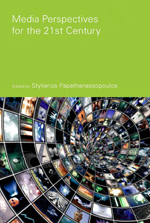Publications
Media Perspectives for the 21st Century
Media Perspectives for the 21st Century
Edited by: Stylianos Papathanassopoulos
Publisher: Routledge, 2011, p. 248
Description
Media Perspectives for the 21st Century brings together key international scholars to explore concepts, topics and issues concerning the communication environment in contemporary democratic societies. It combines qualitative and quantitative approaches to provide an interdisciplinary and truly global perspective that reflects the trends, theories and issues in current media and communication research.
The collection raises significant questions about the study of the media by challenging approaches to major media and societal issues, and analyses in more depth the range of concerns that shape both the present and the future media landscape and the issues these can create for communication. It also investigates the main effects of technological developments on the domain of the news media and journalism.
Divided into two main sections, Part I provides accounts of the role of the media in society, and deals with agendas that affect the field of communications studies. Part II goes on to examine the world of new media and offers analyses on the developments of the 21st century. Chapters deal with various dimensions of media from a number of different perspectives and socio-political contexts, covering a wide range of topics including Social Networking, Political Communication, Public Journalism, Global Infotainment and Consumer Culture.
Media Perspectives for the 21st Century will be highly useful to undergraduate and postgraduate students, as well as researchers and academics, in the fields of media and communication studies, mass communication, journalism and new media.
Contributors
Markus Beiler, Gustavo Cardoso, Nicolas Demertzis, Mark Deuze, Eszter Hargittai, Shanto Iyengar, Marcel Machill , Andrew Mendelson, Matthew P. McAllister, Tristan Mattelart, Ralph Negrine, Zizi Papacharissi, Stylianos Papathanassopoulos, Jessica Roberts, Linda Steiner, Daya Kishan Thussu, Frank Webster.
Contents
List of Tables and Figures Notes on Contributors Abbreviations Introduction Media Perspectives for the 21st Century Stylianos Papathanassopoulos PART I: MEDIA IN THE CONTEMPORARY AGE Chapter 1 Information and Democracy: The Weakening of Social Democracy Frank Webster Chapter 2 The Transformation of Political Communication Ralph Negrine and Stylianos Papathanassopoulos Chapter 3 What Does Information Technology Imply For Media Effects Research? Shanto Iyengar Chapter 4 Infotainment Inc.: The Ascent of a Global Ideology Daya Kishan Thussu Chapter 5 Emotions in the Media and the Mediatization of Traumas Nicos Demertzis Chapter 6 Media, Migrations and Transnational Cultures Tristan Mattelart PART II: COMMUNICATION IN THE DIGITAL ERA Chapter 7 From Mass to Networked Communication Gustavo Cardoso Chapter 8 Media Life Mark Deuze Chapter 9 Consumer Culture and New Media: Commodity Fetishism in the Digital Era Matthew McAllister Chapter 10 How Does the Internet Change Journalistic Investigation and How Should Communication Science Deal with this Issue? Marcel Machill and Markus Beiler Chapter 11 Philosophical Linkages between Public Journalism and Citizen Journalism Linda Steiner and Jessica Roberts Chapter 12 Toward a New(er) Sociability: Uses, Gratifications, and Social Capital on Facebook Zizi Papacharissi and Andrew Mendelson Chapter 13 Minding the Digital Gap: Why Understanding Digital Inequality Matters Eszter Hargittai Index
This collection . on contemporary communications studies showcases current scholarship on media in the digital age and its effect on democratic culture and politics.
Book News
Review (Oct 2011, CHOICE):
Bringing together European and American scholars, this volume examines issues in contemporary and digital communication in democratic societies. Papathanassopoulos (National and Kapodistrian University of Athens, Greece) divides the essays into two parts.
The first considers traditional media concerns, political communication, media effects, and infotainment; Tristan Mattelart's contribution, "Media, Migrations and Transnational Cultures," is especially interesting.
Part 2, "Communication in the Digital Era," is of particular value. Unfortunately, the volume went to press before the "Arab spring" of 2011, which dominated current traditional and digital media and brings challenging, even counterintuitive perspectives to essays in this section. That aside, the examinations of various issues--networked communication, Internet journalism, new sociability, the digital gap--make these essays valuable, fresh resources in contemporary media studies. The argument is that in the future the field of media studies will call for a new concept to interpret recent developments.
New, interactive media are seen to have generated an enormous pool of research on the social implications of emerging media technologies; in an age of user-generated content, the basic concepts and models no longer apply.
Summing Up: Highly recommended. Upper-division undergraduates through professionals; general readers.
-- M. R. Grant, emerita, Wheaton College



